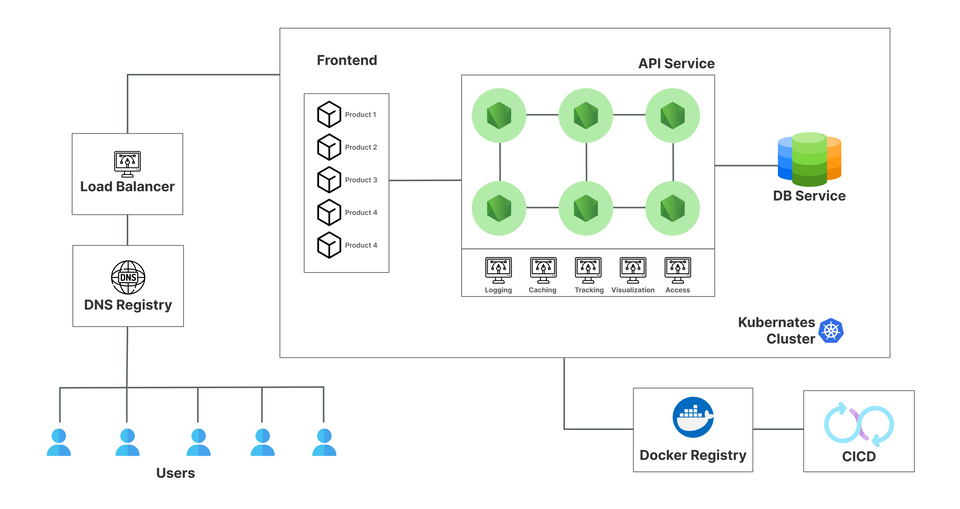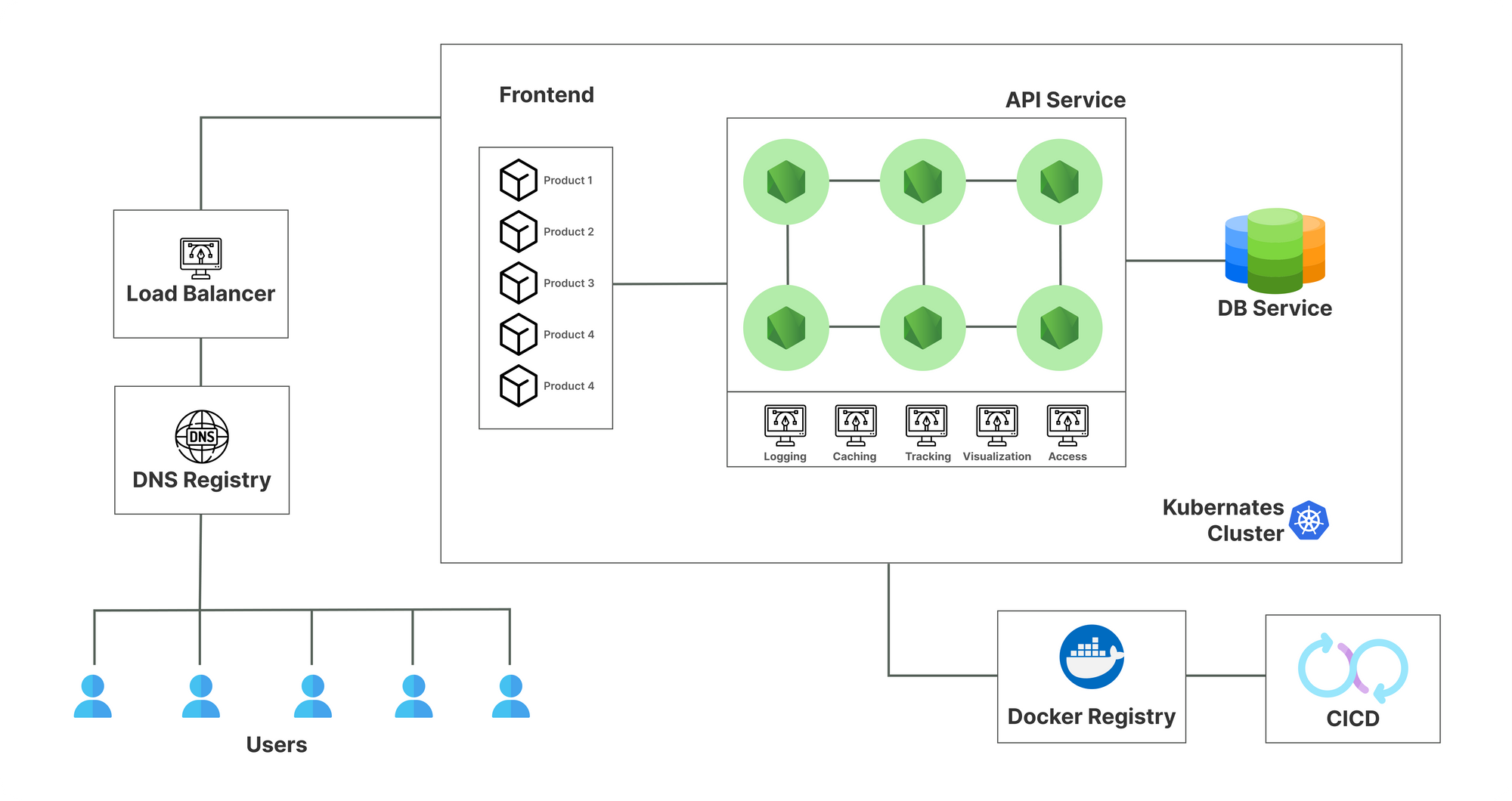Transforming Legacy Monolithic Architecture to Scalable Microservices: A Step-by-Step Guide

In today's fast-paced business landscape, staying competitive requires innovation and adaptability. For companies burdened by the limitations of monolithic architecture, transitioning to a modern microservices-based approach can pave the way for improved scalability, flexibility, and user experience. In this blog post, we'll explore a comprehensive plan to enhance your current old monolithic architecture into a robust, scalable microservices architecture, all while minimizing disruption to your existing applications and business operations.
I. Introduction
A. Embracing Change for a Brighter Future
Welcome to a journey of transformation! Our company, Open Infotech, has been at the forefront of delivering innovative interconnected products to our customers. However, our aging monolithic architecture has begun to hinder our ability to meet growing demands and provide seamless user experiences. This is where our new adventure begins - evolving our architecture to a microservices paradigm without jeopardizing our existing systems.
B. Overcoming Monolithic Challenges
The challenges posed by our current monolithic setup are clear: rigid development cycles, difficulty in scaling components independently, and an intricate web of dependencies. These hurdles limit our agility and innovation. But fear not, as we're about to dive into a solution that overcomes these obstacles and sets us up for success.
C. The Vision of Our Microservices Transformation
Our objectives are ambitious yet achievable: scalability to handle spikes in traffic, flexibility to deploy and update components independently, maintainability to reduce downtime, and an enhanced user experience that keeps our customers delighted. Let's explore how a well-crafted microservices architecture can turn this vision into reality.
II. Microservices Architecture Overview
A. Unveiling the Microservices Paradigm
In a nutshell, microservices architecture is a design approach where an application is built as a collection of loosely coupled services. Each service focuses on a specific business capability and can be developed, deployed, and scaled independently. This contrast with our monolithic setup, where changes to one part often affect the entire system.
B. Advantages of Microservices Magic
Picture this: a streamlined development process, efficient resource utilization, enhanced fault isolation, and accelerated time-to-market. Microservices bring these advantages and more, making them an ideal fit for our evolving needs.
C. Building Blocks of Our Microservices Vision
- Containerization using Docker: Embrace the world of containers, like mini virtual machines that encapsulate applications and dependencies. This ensures consistent environments across different stages of development.
- Orchestration with Kubernetes: Imagine a conductor seamlessly managing a symphony of services. Kubernetes orchestrates our containers, automating deployment, scaling, and management tasks.
- Centralized Database for Data Harmony: To maintain data integrity and consistency, we'll centralize our data storage while still enabling individual services to access the data they need.

III. Microservices Design and Components
A. Segmenting Products for Success
- Identify Individual Products: Break down our product ecosystem into discrete components. Each product should stand as an independent service.
- Defining Microservices: Map out services that encapsulate specific functionalities. This helps us create focused, single-responsibility components.
B. Seamless Service Communication
- API Gateway: Imagine the gateway as a concierge, guiding external requests to the appropriate service. This simplifies external communication and shields internal complexities.
- Pub/Sub Messaging: Communication between services doesn't have to be a waiting game. Use publish/subscribe or message brokers for asynchronous communication, improving responsiveness.
C. Elevating User Experience with Common Services
- User Authentication and Authorization: A seamless experience requires robust user management. Centralize authentication and authorization for consistency and security.
- Notification Service: Keep users engaged with timely notifications. A dedicated service ensures efficient delivery and tracking.
- Insights through Reporting and Analytics: Harness the power of data with centralized reporting and analytics. Make informed decisions and drive innovation.
IV. Containerization with Docker
A. Unveiling Container Magic
Docker brings the magic of containerization. Each service, encapsulated within its container, gains portability and consistency. Development, testing, and production share the same environment, minimizing surprises.
B. Crafting Docker Delight
- Building Docker Images: Prepare images that include your service and its dependencies. These images become the building blocks of your microservices.
- Defining Dependencies and Configurations: Package everything your service needs within the Docker image, ensuring self-sufficiency.
- Consistent Environments: Bid farewell to the "It works on my machine" dilemma. Docker ensures consistent environments across the board.
V. Orchestration with Kubernetes
A. Mastering Kubernetes Symphony
Kubernetes orchestrates our container orchestra. Picture a control tower managing take-offs, landings, and in-flight services. It offers automation, scalability, and resilience.
B. Setting the Stage with Clusters
- Master Nodes for Control: Control plane management happens here. It's like the conductor's podium, directing the symphony.
- Worker Nodes for Execution: These nodes run our containers. They're the talented musicians executing the music.
C. Deploying Microservices with Finesse
- Deployments for Scaling: Kubernetes Deployments automate scaling based on demand. No more manual intervention during traffic surges!
- Network Magic with Services and Ingress: Services enable communication between services, while Ingress manages external access. It's like the stage and the audience entrance.
- CI/CD Pipeline Integration: Keep the symphony in harmony with automated continuous integration and deployment pipelines.

VI. Centralized Database System
A. Unifying Data for Harmony
A centralized database becomes our data maestro, ensuring consistency and reducing data silos.
B. Choosing and Setting the Stage
- Relational Database (e.g., PostgreSQL): Perfect for structured data, maintaining relationships and ensuring data integrity.
- NoSQL Database (e.g., MongoDB): Flexibility is its forte, accommodating varying data structures.
C. Scaling the Data Symphony
- Data Partitioning: Divide and conquer! Partition your data to improve performance and scalability.
- Sharding: Distribute data across multiple servers. It's like having multiple orchestras playing in harmony.
VII. Monitoring, Logging, and Security
A. Monitoring Microservices Maestro
- Prometheus for Metrics: Imagine Prometheus as a diligent audience member, noting each instrument's performance (service metrics).
- Grafana for Visualization: Turn metrics into visual symphonies that help you understand performance trends.
B. Harmonizing Logs with ELK Stack
Centralized logging is our conductor's baton, ensuring harmony across the performance. The ELK stack (Elasticsearch, Logstash, Kibana) orchestrates logs for insight and troubleshooting.
C. Securing the Symphony
- Network Policies: Set rules for how services communicate, ensuring a secure and controlled performance.
- Role-Based Access Control (RBAC): Assign roles to ensure the right players have access to their instruments and sheet music.
- Encryption Enchantment: Encrypt data in motion and at rest, safeguarding the symphony's secrets.
VIII. Scalability and Load Balancing
A. Scaling with Elegance
- Automatic Microservices Scaling: Just like a responsive orchestra, microservices scale automatically based on the audience's size (traffic).
- Horizontal Pod Autoscaling: Kubernetes listens to the applause and adjusts the number of musicians (pods) accordingly.
B. Load Balancing Ballet
Use Kubernetes Service LoadBalancer or Ingress Controllers to distribute the performance load evenly, ensuring every musician has their time to shine.
IX. Challenges and Mitigation
A. Navigating Communication Complexity
Inter-microservice communication can be intricate. Well-defined contracts and API versioning mitigate confusion.
B. Taming Data Consistency Dragons
Distributed systems challenge data consistency. Use eventual consistency models and idempotent operations for a harmonious data dance.
C. Versioning and Compatibility Choreography
Maintain backward compatibility while introducing new versions. An incremental approach and robust testing ensure a seamless transition.
D. Database Schema Evolution
Change is inevitable. Employ database migration strategies to keep the symphony in tune while evolving the schema.
X. Conclusion
A. Embracing the Microservices Symphony
The journey from monolithic to microservices is a transformative one. Scalability, flexibility, and a better user experience await those who dare to innovate.
B. Impact on Our Ongoing Overture
Our products and operations will benefit from this architectural shift, propelling us into a new era of efficiency and growth.
C. A Melody of Continuous Improvement
As the final note fades, remember that innovation doesn't rest. Keep refining and enhancing your microservices symphony for endless possibilities.
Join us on this exciting journey as we transform our architecture, crafting a harmonious and scalable future for your Enterprises. Together, we'll orchestrate success, one microservice at a time.

Are you ready to compose your own microservices symphony? The future beckons, and the stage is set for your company's transformation. Let's embark on this journey together, embracing innovation, and conducting a symphony of success in the world of microservices!

